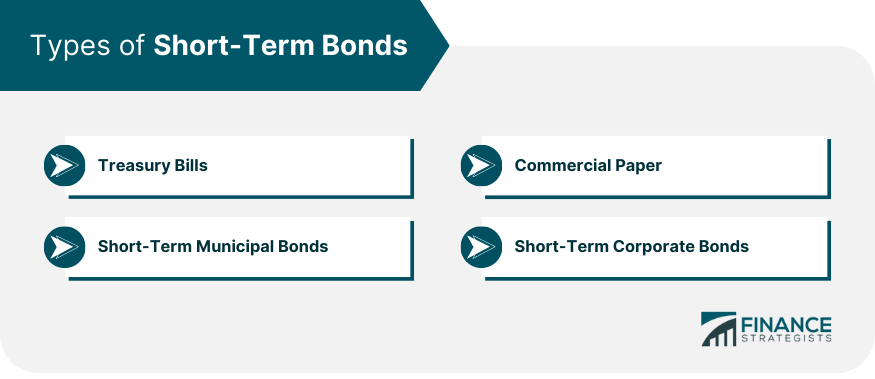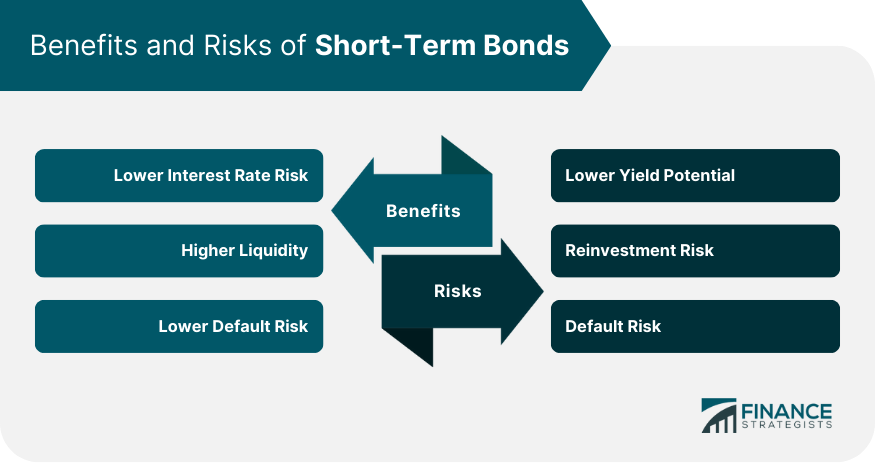Short-term bonds are debt securities issued by governments, municipalities, or corporations with a maturity typically ranging from one to three years. Investors purchase these bonds and, in return, receive regular interest payments and the principal amount upon maturity. Serving as a source of funding for issuers and a relatively low-risk investment for bondholders, short-term bonds have a significant impact on financial markets. For investors, they provide a balance of stability, income, and liquidity, making them a critical part of a diversified portfolio. The yields, risks, and price stability of these bonds are influenced by various factors, including monetary policy, inflation, and the economic climate. Therefore, understanding short-term bonds is crucial for anyone interested in finance or investment, as they play a vital role in managing investment risk and optimizing returns. Short-term bonds work by providing a platform for investors to lend money to issuers such as governments or corporations for a defined period, typically one to three years. In return, the issuer pays interest to the investor periodically, usually semi-annually, until the bond reaches its maturity date. At maturity, the issuer repays the initial amount invested, also known as the principal. As such, short-term bonds serve as a reliable income stream for investors and a means for issuers to raise necessary fund Short-term bonds serve crucial roles in financial markets. For issuers such as governments and corporations, they offer an avenue for raising immediate funds without resorting to bank loans. They act as a short-term debt instrument, providing necessary liquidity for various operational needs. For investors, short-term bonds offer a secure, relatively liquid investment with a predictable return. They serve as a safer investment alternative, especially in volatile markets, thus fostering stability in the broader financial market. Treasury bills, or T-bills, are short-term bonds issued by the federal government with maturity periods ranging from a few days to 52 weeks. They are among the safest investments, backed by the full faith and credit of the U.S. government. Commercial paper is a type of unsecured short-term debt instrument issued by corporations to meet immediate financing needs such as payroll or inventory. These instruments usually mature within 270 days and provide higher returns than government securities due to the higher risk involved. Short-term municipal bonds are issued by state, county, or city governments, or their agencies, to fund public projects. They offer tax advantages, as their interest income is often exempt from federal taxes and sometimes from state and local taxes. Short-term corporate bonds are issued by businesses looking to raise capital for short-term needs. They typically offer higher yields than government or municipal bonds due to the increased risk. Short-term bonds are characterized by their shorter maturity dates. The shorter timeframe can lead to less price volatility compared to medium-term or long-term bonds. The interest rates on short-term bonds are typically lower than on long-term bonds due to the reduced risk exposure. The rate is fixed and paid periodically until the bond matures. Short-term bonds are generally more liquid than long-term bonds, making them easier to sell if the investor needs quick access to cash. Compared to long-term bonds, short-term bonds generally have a lower risk of price fluctuations due to interest rate changes. However, like all bonds, they carry a risk of default. The relatively lower volatility of short-term bonds can provide stability in a portfolio during turbulent market conditions. Short-term bonds can be a steady source of income generation, with typically more regular and predictable payments than stocks. In an environment where long-term interest rates are expected to rise, short-term bonds can provide a strategy to mitigate the associated risks. Investors can buy short-term bonds directly from issuers such as the government or corporations. For instance, Treasury bills can be bought directly from the U.S. Treasury at auctions. Short-term bonds can also be purchased on the secondary market from other investors. The price may be more or less than face value, depending on market conditions. Investors can also gain exposure to a diversified portfolio of short-term bonds by investing in short-term bond funds or exchange-traded funds (ETFs). This approach can provide greater diversification and professional management. 1. Lower Interest Rate Risk: Short-term bonds are less sensitive to interest rate changes than long-term bonds, offering a lower interest rate risk. As such, their prices are more stable in a changing interest rate environment. 2. Higher Liquidity: Due to their shorter maturities, short-term bonds generally provide investors with higher liquidity, making them an excellent choice for investors who may need to access their funds on short notice. 3. Potentially Lower Default Risk: Short-term bonds typically carry a lower risk of issuer default compared to long-term bonds. The shorter maturity period reduces the duration of exposure to the issuer's credit risk. 1. Lower Yield Potential: As a trade-off for their stability and lower risk, short-term bonds usually offer lower yield potential compared to medium-term and long-term bonds. 2. Reinvestment Risk: Short-term bonds expose investors to reinvestment risk, the risk that the funds' Reinvestment Risk will need to be reinvested at a lower interest rate when the bond matures. If interest rates fall, investors may not be able to achieve the same rate of return when reinvesting their capital. 3. Default Risk (in certain cases): Although typically lower than in long-term bonds, short-term bonds can still carry a default risk, particularly in the case of commercial paper and certain corporate bonds. While long-term bonds typically offer higher yields due to increased risk and longer commitment of capital, short-term bonds provide lower risk and higher liquidity. Investors must balance their needs for yield, risk tolerance, and liquidity when choosing between the two. Medium-term bonds offer a middle ground between short and long-term bonds in terms of yield, risk, and liquidity. Depending on market conditions and the investor's personal circumstances, medium-term bonds can offer an attractive alternative. Unlike short-term bonds, floating rate bonds have interest payments that adjust with market interest rates. While this can provide protection against rising interest rates, it also introduces uncertainty regarding future income from the bond. Short-term bond yields are sensitive to changes in monetary policy. If the central bank lowers interest rates, the yield on newly issued short-term bonds will also decline. During periods of strong economic growth, corporations are more likely to issue short-term debt, increasing the supply of corporate short-term bonds. The phase of the business cycle can also influence the risk and return characteristics of short-term bonds. Although short-term bonds are less exposed to inflation risk than Inflation and Short-Term Bonds long-term bonds, unexpected increases in inflation can still erode the real return of short-term bonds. This is especially true if the central bank raises interest rates in response to inflation, causing bond prices to fall. Short-term bonds are vital instruments in the financial market, offering a balance of stability, income, and liquidity for investors. These securities, issued by governments, municipalities, or corporations, have maturities ranging from one to three years. They come with distinctive characteristics, such as lower interest rate risk, higher liquidity, and potentially lower default risk compared to longer-term bonds. However, they also pose certain risks like reinvestment risk and, in some cases, default risk. These bonds are heavily influenced by factors like monetary policy, economic growth, and inflation. Investing in them can be done directly from issuers, through the secondary market, or via short-term bond funds and ETFs. Understanding short-term bonds is essential for anyone interested in finance or investment, as they significantly aid in managing investment risk and diversifying portfolios.What Are Short-Term Bonds?
How Short-Term Bonds Work
Short-Term Bonds in the Financial Market
Types of Short-Term Bonds
Treasury Bills
Commercial Paper
Short-Term Municipal Bonds
Short-Term Corporate Bonds

Characteristics of Short-Term Bonds
Duration and Maturity
Interest Rates
Liquidity
Risk Profile
Role of Short-Term Bonds in Portfolio Diversification
Providing Stability in Volatile Markets
Income Generation
Mitigating Long-Term Interest Rate Risk
How to Invest in Short-Term Bonds
Direct Purchase From Government or Corporate Entities
Secondary Market Purchase
Short-Term Bond Funds and ETFs
Benefits and Risks of Short-Term Bonds
Benefits
Risks

Comparing Short-Term Bonds to Other Bonds
Short-Term Bonds vs Long-Term Bonds
Short-Term Bonds vs Medium-Term Bonds
Short-Term Bonds vs Floating Rate Bonds
Impact of Economic Factors on Short-Term Bonds
Monetary Policy and Short-Term Interest Rates
Economic Growth and Business Cycle Phases
Inflation and Short-Term Bonds
Conclusion
Short Term Bonds FAQs
Short-term bonds are debt securities with a maturity period typically between one to three years. They are issued by governments, municipalities, or corporations to raise funds and offer a lower-risk investment option for investors.
The benefits of investing in short-term bonds include lower interest rate risk, higher liquidity, and potentially lower default risk compared to long-term bonds. These characteristics can make them a valuable part of a diversified portfolio.
Despite their benefits, short-term bonds carry risks such as lower yield potential, reinvestment risk, and default risk. The lower yield is a trade-off for their stability, while reinvestment and default risks depend on market conditions and the financial health of the issuer.
Interest rates inversely affect bond prices. However, due to their shorter maturity period, short-term bonds are less sensitive to changes in interest rates, resulting in lower interest rate risk compared to long-term bonds.
Short-term bonds can help diversify an investment portfolio by providing a balance of stability, income, and liquidity. They also have a lower correlation with volatile assets like stocks, which can help reduce overall portfolio risk.
True Tamplin is a published author, public speaker, CEO of UpDigital, and founder of Finance Strategists.
True is a Certified Educator in Personal Finance (CEPF®), author of The Handy Financial Ratios Guide, a member of the Society for Advancing Business Editing and Writing, contributes to his financial education site, Finance Strategists, and has spoken to various financial communities such as the CFA Institute, as well as university students like his Alma mater, Biola University, where he received a bachelor of science in business and data analytics.
To learn more about True, visit his personal website or view his author profiles on Amazon, Nasdaq and Forbes.











